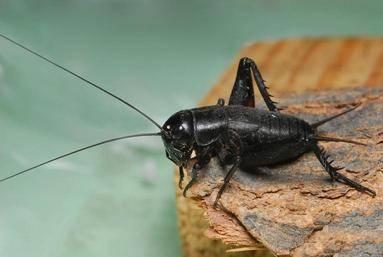About crickets
-
Home invading crickets are usually one of three kinds.
-
The house cricket is 19-22 mm (3/4 - 7/8 inch) long, light yellowish-brown with three dark bands on the head. They are especially fond of warmth but can be found in any part of the home.
-
Field crickets are robust black insects 13-33 mm (1/2 - 1 1/4 inches) long. They are usually found on the lower floors and in the basement.
-
The camel or cave cricket is named for its humped appearance when viewed from the side. These crickets have extremely long antennae and rear legs. They range from light tan to dark brown in color and are 13-33 mm (1/2 - 1 1/4 inches) in length. Camel crickets’ desire for dark moist places almost always restricts them to damp basements and crawl spaces.
-
-
Of the three common cricket invaders, only house and field crickets sing. Sound is produced when the males rub a sharp edge at the base of one front wing along a file-like ridge on the underside of the other wing. The warmer the temperature, the faster they sing. Count the number of chirps in 15 seconds then add 40 for a temperature estimate in degrees F. There are three types of songs: a call to attract females, an aggressive song to warn away other males, and a courtship song prior to mating. Crickets hear songs with “eardrums” located on their front legs.

Field cricket (Gryllus pennsylvanicus). Photo: Joseph Berger, Bugwood.org

Camel cricket (Ceuthophilus sp.). Photo: Kansas Department of Agriculture , Bugwood.org
Damage
-
Chirping is the most annoying trait that people encounter with indoor crickets.
-
Chewing damage can occur on fabrics made of wool, silk, nylon, rayon, cotton or linen. Furs and rubber may also be nibbled. All fabrics are much more liable to attack if they are soiled with body oils, perspiration, or food stains.
-
Unless dozens of crickets are in the home, damage is usually so minor it goes unnoticed.
Management
Cricket-proofing
-
Although house and camel crickets may reproduce indoors, most pest crickets wander in from outside.
-
A cricket chirping indoors signals the need for some minor home repairs. Doors should fit tightly; adjust, repair, or replace weather-stripping and thresholds. Caulk, screen, plaster, or use polyurethane insulating foam around basement window frames, dryer vents, and entrances for plumbing and wiring. Crawl space vents should be properly screened.
-
To limit the numbers of crickets in the immediate vicinity of the home, practice good sanitation. Clean up piles of leaves, bricks or lumber next to the foundation. Store firewood away from the foundation.
-
Groundcovers growing within least 18 inches of your home should be trimmed back. Mow lawns regularly.
-
Crickets often occur under garbage cans in great numbers. Elevating the cans on bricks or placing them on a cement pad will eliminate hiding areas.
-
House and field crickets are attracted to light. Use shades or drapes on brightly lit windows and limit the use of outside house lights during cricket season. If porch lights are necessary, try one of the non-attracting yellow bug lights.
-
The vacuum cleaner is one of the most effective and least toxic means of eliminating invading crickets in the house. If you can’t catch them with the vacuum, try placing sticky traps near their singing areas. These are the same traps sold for cockroach control in the local grocery and hardware stores.
-
Solving high moisture problems in your basement will greatly reduce or eliminate camel crickets. Fix leaks, dehumidify, and use sticky traps.
-
Indoor cricket control can be achieved by the non-chemical, non-toxic methods listed above. In extreme situations, the use of baits or perimeter sprays outdoors is justified while sanitation measures and home repairs are being completed. A variety of products available to homeowners are labeled for cricket control.
-
Licensed pest control operators can be hired if you prefer not to handle pesticides.
-
Chemical control should only be used in conjunction with permanent, structural repairs and sanitation. Steps taken to discourage and exclude crickets will serve the same function for other occasional invaders as well and may even yield energy savings.
Based on publication EL 50 Crickets, authors: Nancy L. Breisch Ph.D., Research Entomologist (Retired) and Barbara L. Thorne, Ph. D., Asst. Professor, Entomology (Retired), University of Maryland College Park. Compiled by Debra Ricigliano, HGIC
rev. 2020
